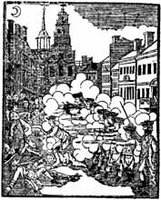John Field: breeches-maker
Back in March, I posted about what little is known of Patrick Carr, one of the victims of the Boston Massacre. He was working for a maker of leather breeches named John Field, and I’ve found more information about that man. Like Carr, Field appears to have immigrated to Boston from Ireland, but he was wealthier.
Church records show that Field’s wife had been named Catherine (or Katherine) Ryan, and they had married at the Presbyterian Meeting-House on 15 Jan 1767. They had their children baptized in Anglican churches: Mary in 1769, Catherine in 1772, John in 1774 (all at King’s Chapel), then Margaret in 1781 and Betsy in 1786 (at Trinity). The family was close to a blacksmith named John Magner and his wife Mary; the couples sponsored the baptisms of each other’s children. In February 1772, Field joined the Charitable Irish Society of Boston; most of its members were immigrants from Ireland.
Field stayed in Boston through the siege of 1775-76 rather than joining the provincials outside. Then he stayed through the evacuation of March 1776 rather than leaving with the British military. The Provincial Congress had him arrested for questioning, but he seems to have been released quickly.
Field might then have tried farming in Chester, Massachusetts. The baptismal record of Margaret Field in 1781 names her father as “John Field of Chester.” In the 13 June 1782 Independent Chronicle, John Field advertised a farm for sale in Chester. But he still owned real estate in Boston; in late 1781 he sold a lot to John Magner.
Another source on John Field are two narratives of a poor black woman from Rhode Island named Phillis Merritt Wanton. In 1784, she testified
that the next day after her Master [John] Merritt [of Providence] died, she was sold by Mr. Overring, the executor, to one Mr. John Field of Boston, a leather breeches maker, and in that month went to live in Boston with the said Field as his servant; that some years ago the said Field told her she might go and get her own living; and that he went away out of the country; whereupon she came to Providence about four years agoI can date John Merritt’s death to 1770, which would mean Wanton was in the Field household for about ten years, perhaps from the time he moved onto Cornhill, one of Boston’s main streets, until he left town to try farming.
However, in 1800 Wanton described her history differently. She then said that Field had bought her for £100 after Merritt’s death, but then sold her to a “Mr. Peck” of Boston, who granted her freedom “about the time of the blockade of that place by the British.” Wanton may have been trying to shape her history to prevent the Providence officials from ordering her to leave that town—in which case, she was unsuccessful. Both these accounts are transcribed in Ruth Wallis Herndon’s Unwelcome Americans.
The 9 Sept 1800 Massachusetts Mercury reported that “Mrs. Catharine Field, Aet. [i.e., aged] 46, widow of Mr. John Field,” had died. So John had died some time before—perhaps in 1787, when the town granted Catherine a stand in Market Square for selling fruit and vegetables. But what’s most interesting about this notice is that, if the age is correct, John Field had married Catharine when she was only about twelve or thirteen years old.

